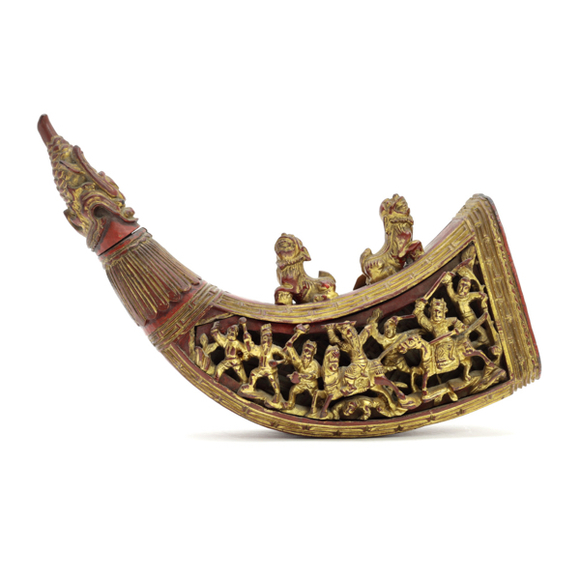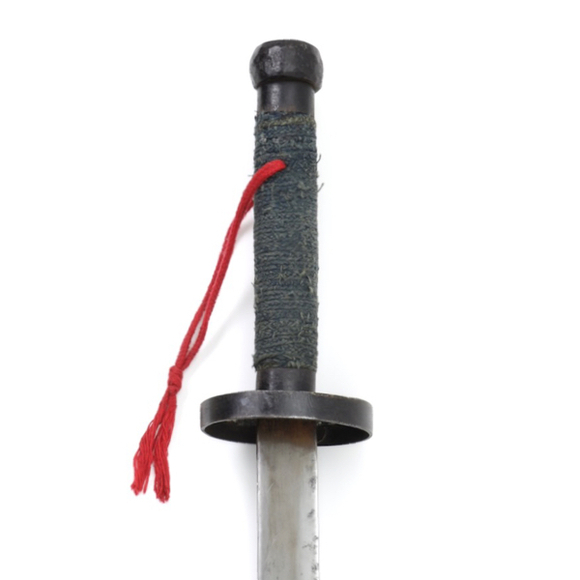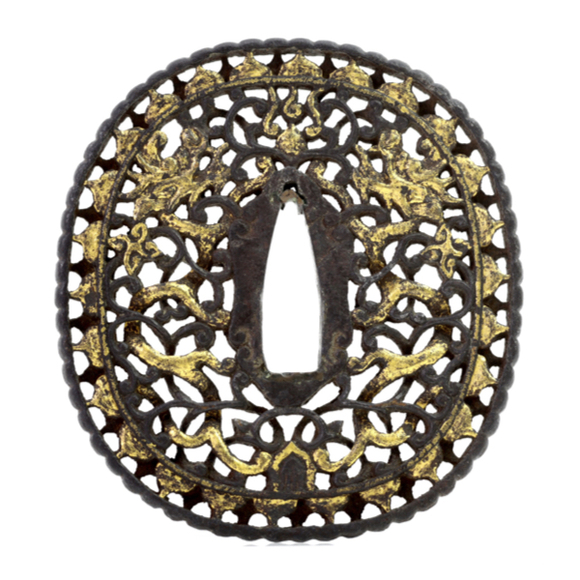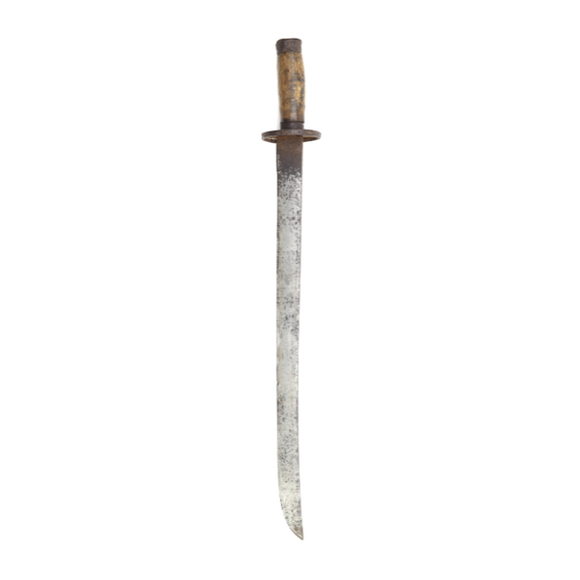With a golden damascened lock of the Indo-Portuguese type.

Overall: 69.2 cm
Blade: 53 cm
Blade thickness:
forte 6.5 mm
middle 5 mm
near tip 4 mm
Blade width:
forte 34 mm
middle 29.5 mm
near tip 23 mm
Weight: 529 grams
P.o.b. 13.5 cm from guard
(handle side)
Overall: 69.2 cm
Blade: 53 cm
Blade thickness:
forte 6.5 mm
middle 5.5 mm
near tip 4 mm
Blade width:
forte 34 mm
middle 21 mm
near tip 23.5 mm
Weight: 529 grams
P.o.b. 13.5 cm from guard
(handle side)
(Indeed, the pair is exactly the same length, to the millimeter.)
China, Qing dynasty
Probably Guangzhou (Canton)
Southern China
Iron, steel, brass, hardwood.
First half 19th century
Introduction
China had a strong tradition of double wielding of swords, and double shortswords are encountered on artworks from at least the 18th century onwards. These pieces were first and foremost made for a native market but happened to make good souvenirs due to their size that easily fit steamer trunks of the day. As a response, in the late 19th century many were made purely with the tourist market in mind. As a result, many today are immediately dismissed as tourist curio's while that is not always the case. Quality varies a lot among the genre, from bad purely decorative pieces to very well-made weapons, some with very nice mounts.
Here is a good set of the first half of the 19th century, with large and rather heavy, forge folded blades.
Description
A set of double straightswords, or shuangjian (雙劍). Their blades of triangular cross-section, the flats of which are meant to sit together in a single scabbard. The blades are of good quality steel, in recent polish to bring out their details. The surface shows a subtle meandering wood grain pattern of softer iron, with high carbon edge plates exposed at the edges. Also noticeable are the cloudy effects of the heat treatment that made the edges very hard and brittle while the bodies provide toughness. According to the polisher, Philip Tom, the difference in hardness of blade and body on this set were extreme with very hard edges on a very soft body.
The cast brass mounted hilts are of classic form with zoomorphic guards depicting the taotie (饕餮), a monster from Chinese folklore that was so voracious that it devoured even its own lower jaw. This is quite like kirtimukha of the Hindu cultural sphere, and there is probably an ancient relationship between the two. The rendering of the faces is detailed, their presence strong, unlike very similar guards on most late Qing duanjian that lack detail and look weak.
The octagonal pommels both carry a taiji (literally: "grand ultimate") symbol in relief, surrounded by bagua, the "Eight Diagrams" that represent changes in the balance of the cosmic powers of yin and yang that are juxtaposed in the taiji. The ferrules have floral decoration, but are much worn: This indicates extensive use by a previous owner.
Hardwooden grips and their iconography
Both grips are of carved hardwood in the typical southern Chinese fashion, as also seen on hudiedao. The decoration on each handle consists of a sunken panel with swastika fretwork, surrounded by a greek key pattern. Each panel is further decorated with a symbol representing a Daoist immortal. The carving is nice and deep, and well executed.

Sword A (left) has a sword, referring to Lu Dongbin, the patron of scholars and barbers.
He rids the world of evils.
Sword B (right) has a fan, referring to Zhongli Quan who represents the military man.
He is chief of the Eight Immortals and the posessor of the Elixir of Life.
He can provide immortality and resurrect the dead.
Comparable examples
1.) A comparable set is held in the Metropolitan Museum, accession number 36.25.1480a–c

Notice the identical style hilt mounts, including the octagonal Eight Trigrams pommels. The handles are amber colored horn.
It came from the George Cameron Stone collection, bequeathed to the museum in 1935.
2.) A similar set I briefly owned, with gilt mounts and elaborately carved ivory grips. See its listing here

This set was a deluxe version of this type, with high-end materials and very fine work especially on the grips.
Based on style and workmanship on the handles it was attributed to Guangzhou, 1830's-1840's.
Attribution
The straightsword was traditionally a weapon of the literate. Among surviving antiques the shortswords are far more numerous than long swords and sets of double swords are fairly common. Who were the market? It seems that carrying single or double shortswords was fairly common in the Qing. A Qianlong scroll depicting minorities across the empire depict many men of different ethnicities with different clothing, but many wear one or two shortswords that appear of similar type across these peoples. This seems to point to a tradition of wearing them, perhaps during long travel, that spanned the empire.
There were also lots of traveling duelists around. Adventurer William Mesny who eventually became a general in the Qing army described:
Fu Hu Chün 副護軍. Second battalion of guards. This is an extra battalion of guards, all picked young Kuei-chou men, between twenty or thirty years old, real swashbucklers, good looking and lavishly decorated with scars obtained in battle or duel. Every other man of them has a Yüeh Ching, moon instrument (a sort of short handled like discular guitar) slung to his back and carries a dagger as well as a fancy shortsword at his side. These are duelists by profession apparently and also troubadourists of the mountains too. Each warrior has his fancy girl at home and an extra one or two in every town. Duelling and love-song singing is a sort of pastime with them when not engaged in the stern realities of actual warfare.
They fight duels with each other sometimes as soon as they are cured from former wounds as acts of revenge, called Pao Chou (報仇), and they sometimes take up each other's cause, as for instance in case of wrongful treatment of the weak and defenseless by the strong, or using might against right; this kind of protection or defense is called Pao Pu Ping (抱不平), and is much in vogue in Kuei-chou at this present time. Many young men learn the use of weapons and take a great deal of physical exercise so as to accustom themselves to hardships with a view of avenging some one's wrongs. Some or many such are now enrolled in the ranks of our Fu Hu Chün, the second battalion of General Liu's guards. Nearly all these young men have a servant to do their camp work for them, to act as squires to knights of olden times. Soldiers of the guard battalions all hare the characters Ch'in Ping 親兵 Body-Guard, Garde du Corp, sew on front and back of their uniforms, whilst ordinary soldiers have the word Yung 勇, which means Brave of Knight. It is usually from the ranks of distinguished Yung the Ch'in ping are recruited; all-being picked men as often for their good looks as their martial qualities, as may be easily perceived on parade.
From Mesny's Miscellany, 18 March 1905.
The above narrative of traveling, dueling heroes with small guitar-like instruments almost reminds of Zorro of Western pop culture. It shows that there was a fairly large, unregulated market for small arms that were actually put to use. The fact they they had these instruments and even servants shows that they were not poor, and actually often of some means.
Conclusion
A good set of earlier double shortswords that were probably made in Guangzhou in the first half of the 19th century. Size, weight, balance and the extensive wear on the ferrules suggest it may have been made for native use. Perhaps some of these were in fact made for fighters such as the men described above by William Mesny.























Probably of Southern origin, with a straight blade and flaring tip.
A simple utilitarian weapon, probably made for rural martial artists or militia.
A standard pattern Qing military saber, but with the rare addition of a label in Manchu.






